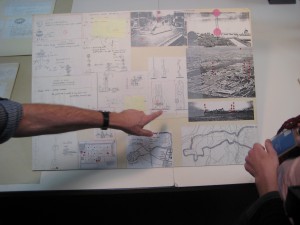(Fred points at one of the presentation boards for Japan Net. This is one of the nicest parts about being at the CCA: the discussions that happened when other people stopped by to see what I was looking at, or that happened over their material.)
My fellowship at the Canadian Centre for Architecture ended last week. It was a stellar month. I realized every time I walked in the door, I wore a grin and my pace quickened as I headed down the hall to the Study Centre. I will very much miss the place and the people, both the scholars and the people at the CCA.
The overall goal of my trip was to look at the projects that Cedric Price did that had something to do with information flows and communication. In reality, that could mean all of his projects, but given the enormity of his archive, that wasn’t going to be the case. I mentioned previously that I looked at Generator (the subject of my master’s thesis) and Oxford Corner House (a proto cyber cafe info hive from 1966), but I also saw Magnet (a set of urban interventions to instigate different interactions throughout London, 1996), the Birmingham and Midland Headquarters (which reused parts of Oxford Corner House, 1968), Price’s own information storage system for his office (punchcards and a possible computer), Japan Net (series of info pods for Kawasaki, Japan), and McAppy (a construction site safety program, project management system and portable, prefabbed construction huts).
I did not set out with the goal of finding this, but I think Price was truly an information architect — that is, an architect whose main material and media was information. (I also believe he came across the early use of the term “information architecture” in 1968, in an article in Datamation.) Every project begins with this collection of data; the key activities have to do with the structuring of that data and information into categories — and then into physical communication and circulation in the form of a design for a building. He didn’t build many things and it leads me to believe that his practice had more to do with the sum total of all the data and information and drawings and texts and correspondence and charts.In any case, there’s a ton of material to work through that hasn’t really been analyzed or published about, with a few exceptions. I’d like for Price to be as well known to the technology/design community as Nicholas Negroponte and Christopher Alexander are.
In other news, I went to my 20 year high school reunion. It was as weird as I’d expected but also, great fun. Best of all, I reconnected with my high school best friend. It’s been a hard year for friendships and it felt wonderful to realize that Nicole is there and beautiful and doing well.
Tomorrow, I fly back to LA. I’m pondering doing a juice fast. I’m looking forward to going running and getting back to eating healthfully and sleeping well.

Hi there!
I greatly enjoy your blog – it is very interesting indeed! I know you are very busy researching, but I was wondering if there was anything you would be able to tell me about the Oxford Corner House project by Cedric Price? As in, what books I could look at, any drawings I should be looking at etc.
If you be able to help me in anyway, I would be very grateful!
Kind regards
Akhil Bakhda